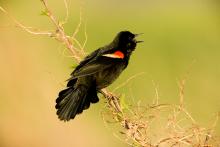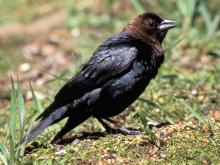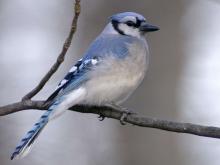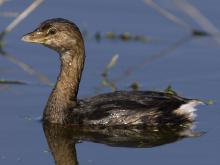Birds
Media

Species Types
Scientific Name
Quiscalus quiscula
Description
The common grackle makes “a mistake . . . in trying to sing,” a prominent birder once wrote of its kree-del-eeeeks and chlacks. Yet its iridescent purples, blues, and bronzes please the viewer despite the harshness of the voice.
Media

Species Types
Scientific Name
Agelaius phoeniceus
Description
These crimson-shouldered residents of marshes, wet meadows and weedy roadside ditches are well-known by most rural Missourians. Their “konk-o-REEE” song likely emanates from every pond in Missouri.
Media

Species Types
Scientific Name
Euphagus carolinus
Description
Missourians most often see rusty blackbirds during spring and fall migration, though in southern Missouri they sometimes stay through the winter. Look for them foraging in pastures and fields near water.
Media

Species Types
Scientific Name
Molothrus ater
Description
The brown-headed cowbird never builds a nest of its own. Instead, it lays eggs, one at a time, in the nests of other birds. Each cowbird is raised by unwitting foster parents.
Media

Species Types
Scientific Name
Cathartes aura
Description
The turkey vulture is perhaps the most commonly seen soaring bird in our state. Identify this "buzzard" from below by its shallow V-angled wing posture and two-toned pattern, with the forward edge of the wings black and the trailing half gray or silvery.
Media

Species Types
Scientific Name
Dolichonyx oryzivorus
Description
The male bobolink is the only North American bird that has light feathers above and dark feathers below. In fall and winter, the male resembles the buffy and brown-streaked female.
Media

Species Types
Scientific Name
Cyanocitta cristata
Description
Blue jays are notable for their loud voices, blue and white plumage, strong black bill, relatively large size and the distinctive crest atop their heads.
Media

Species Types
Scientific Name
Corvus brachyrhynchos
Description
Crows scarcely need an introduction. A flock of them flapping over a cornfield, against an October sky, is a scene worthy of a painting, but the corn farmer doesn’t see it that way!
Media

Species Types
Scientific Name
Podilymbus podiceps
Description
Small, brown, ducklike birds, pied-billed grebes have thick gray bills with a dark ring around the middle in summer. They dive underwater to forage.
Media

Species Types
Scientific Name
Podiceps auritus
Description
Horned grebes are small ducklike birds that may be seen in Missouri during migration and locally in the winter. Breeding coloration is different from that of winter.
See Also







Media

Species Types
Scientific Name
Hemaris diffinis
Description
The snowberry clearwing is a moth that confuses people because it looks like a bumblebee and flies like a hummingbird!
Media

Species Types
Scientific Name
Hyles lineata
Description
The white-lined sphinx moth sometimes confuses people because it flies, hovers, and eats from flowers like a hummingbird. The adults often fly during daylight hours as well as in the night and are often found at lights.
Media

Species Types
Scientific Name
Darapsa myron
Description
The Virginia creeper sphinx moth is common in woods and brushy areas and comes to lights at night. The larvae eat Virginia creeper and grape leaves.
Media

Species Types
Scientific Name
Perimyotis subflavus (formerly Pipistrellus subflavus)
Description
Tri-colored bats, formerly called eastern pipistrelles, are relatively small and look pale yellowish or pale reddish brown. The main hairs are dark gray at the base, broadly banded with yellowish brown, and tipped with dark brown.
Media

Species Types
Scientific Name
Myotis grisescens
Description
Gray myotises are difficult to distinguish from other mouse-eared bats. A key identifying feature of the gray myotis is that its wing is attached to the ankle and not at the base of the toes. It’s an endangered species.
Media

Species Types
Scientific Name
Myotis lucifugus
Description
The little brown myotis (little brown bat) is one of our most common bats, but populations are declining. White-nose syndrome has taken a heavy toll in northeastern states. This species is now listed as vulnerable across its range.
Media

Species Types
Scientific Name
Myotis sodalis
Description
The Indiana myotis, or Indiana bat, summers along streams and rivers in north Missouri, raising its young under the bark of certain trees. It is an endangered species.
About Birds in Missouri
About 350 species of birds are likely to be seen in Missouri, though nearly 400 have been recorded within our borders. Most people know a bird when they see one — it has feathers, wings, and a bill. Birds are warm-blooded, and most species can fly. Many migrate hundreds or thousands of miles. Birds lay hard-shelled eggs (often in a nest), and the parents care for the young. Many communicate with songs and calls.





















